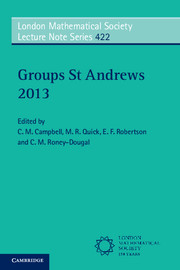Book contents
- Frontmatter
- Contents
- INTRODUCTION
- Approximate subgroups and super-strong approximation
- Width questions for finite simple groups
- Profinite properties of discrete groups
- GL(n, Z), Out(Fn) and everything in between: automorphism groups of RAAGs
- Permutation groups and transformation semigroups: results and problems
- New progress on factorized groups and subgroup permutability
- A survey on the normalizer problem for integral group rings
- A survey on Clifford-Fischer theory
- A generalisation on the solvability of finite groups with three class sizes for normal subgroups
- Automorphism groups of non-orientable Riemann surfaces
- What are the C2-groups?
- Resurrecting Wells’ exact sequence and Buckley's group action
- Recent work on Beauville surfaces, structures and groups
- Something for nothing: some consequences of the solution of the Tarski problems
- The groups of projectivities in finite planes
- On the relation gap and relation lifting problem
- Some results on products of finite subsets in groups
- Formal languages and group theory
- On the Castelnuovo-Mumford regularity of the cohomology of fusion systems and of the Hochschild cohomology of block algebras
- Recent advances on torsion subgroups of integral group rings
- On finite groups with small prime spectrum
- Solvability criteria for finite loops and groups
- The rational subset membership problem for groups: a survey
- A survey of Milnor laws
- Capable p-groups
- On the normal structure of a finite group with restrictions on the maximal subgroups
- Certain monomial characters and their normal constituents
- Recognition of finite quasi-simple groups by the degrees of their irreducible representations
- Generalized Baumslag-Solitar groups: a survey of recent progress
- Zeta functions of groups and rings – recent developments
What are the C2-groups?
Published online by Cambridge University Press: 05 September 2015
- Frontmatter
- Contents
- INTRODUCTION
- Approximate subgroups and super-strong approximation
- Width questions for finite simple groups
- Profinite properties of discrete groups
- GL(n, Z), Out(Fn) and everything in between: automorphism groups of RAAGs
- Permutation groups and transformation semigroups: results and problems
- New progress on factorized groups and subgroup permutability
- A survey on the normalizer problem for integral group rings
- A survey on Clifford-Fischer theory
- A generalisation on the solvability of finite groups with three class sizes for normal subgroups
- Automorphism groups of non-orientable Riemann surfaces
- What are the C2-groups?
- Resurrecting Wells’ exact sequence and Buckley's group action
- Recent work on Beauville surfaces, structures and groups
- Something for nothing: some consequences of the solution of the Tarski problems
- The groups of projectivities in finite planes
- On the relation gap and relation lifting problem
- Some results on products of finite subsets in groups
- Formal languages and group theory
- On the Castelnuovo-Mumford regularity of the cohomology of fusion systems and of the Hochschild cohomology of block algebras
- Recent advances on torsion subgroups of integral group rings
- On finite groups with small prime spectrum
- Solvability criteria for finite loops and groups
- The rational subset membership problem for groups: a survey
- A survey of Milnor laws
- Capable p-groups
- On the normal structure of a finite group with restrictions on the maximal subgroups
- Certain monomial characters and their normal constituents
- Recognition of finite quasi-simple groups by the degrees of their irreducible representations
- Generalized Baumslag-Solitar groups: a survey of recent progress
- Zeta functions of groups and rings – recent developments
Summary
The Classification of Finite Simple Groups (CFSG) is a theorem that states that if G is a finite simple group, then it is either:
(i) A cyclic group of prime order,
(ii) A an alternating group Alt(n) for some n ≥ 5,
(iii) A simple group of Lie type, or
(iv) A sporadic simple group.
The original proof of the CFSG was a patchwork of interrelated individual theorems with spectacular contributions by many mathematicians. It was finally completed in 2004 with the monumental work of M. Aschbacher and S. Smith, which classified the so-called quasithin groups [AS].
The project of D. Gorenstein, R. Lyons and R. Solomon (the GLS-project) aims to produce what is known as the Generation-2 proof of the Classification Theorem. The outcome of this impressive work will be a new, coherent proof of the CFSG and it will be (and is being) published in the special series of monographs by the AMS [GLS1].
The basic strategy of the proof of the CFSG is to consider a simple group X which is a minimal counterexample to the theorem. This is a finite group all of whose proper simple subsections are listed in the statement of the CFSG (in general, a group satisfying this condition is called a K-proper group). Thanks to the celebrated result of W. Feit and J.G. Thompson [FT], one pays special attention to the centralisers of involutions (elements of order 2) of X. According to the structure of those centralisers, the group X is always either of even type or of odd type (this is by definition [GLS1, p.58]). Thus the proof of CFSG is reduced to the classification of groups of even type and classification of groups of odd type. While the classification of groups of odd type is currently nearing its completion in the work of Lyons and Solomon [GLS5], [GLS6], [GLS7], the classification of groups of even type remains to be researched. Let us therefore discuss this important notion ([GLS1, 21.3]). We abide by the definitions in [GLS3], in particular, the description of the automorphisms of groups of Lie type (which is given in [GLS3, 2.5.13]) is especially important to us.
- Type
- Chapter
- Information
- Groups St Andrews 2013 , pp. 194 - 208Publisher: Cambridge University PressPrint publication year: 2015



